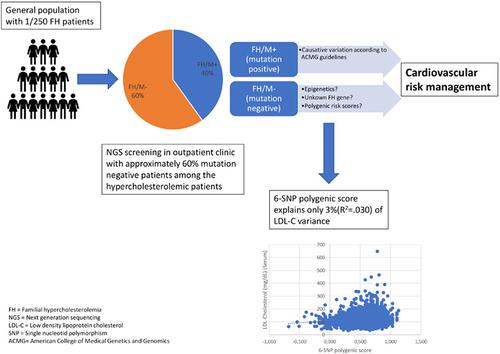当前位置:
X-MOL 学术
›
Clin. Genet.
›
论文详情
Our official English website, www.x-mol.net, welcomes your
feedback! (Note: you will need to create a separate account there.)
Mutation spectrum and polygenic score in German patients with familial hypercholesterolemia.
Clinical Genetics ( IF 2.9 ) Pub Date : 2020-08-08 , DOI: 10.1111/cge.13826 Lorenz Rieck 1 , Frieda Bardey 1 , Thomas Grenkowitz 2 , Lars Bertram 3, 4 , Johannes Helmuth 5 , Claudia Mischung 5 , Joachim Spranger 1 , Elisabeth Steinhagen-Thiessen 1 , Thomas Bobbert 1 , Ursula Kassner 1 , Ilja Demuth 1, 6
Clinical Genetics ( IF 2.9 ) Pub Date : 2020-08-08 , DOI: 10.1111/cge.13826 Lorenz Rieck 1 , Frieda Bardey 1 , Thomas Grenkowitz 2 , Lars Bertram 3, 4 , Johannes Helmuth 5 , Claudia Mischung 5 , Joachim Spranger 1 , Elisabeth Steinhagen-Thiessen 1 , Thomas Bobbert 1 , Ursula Kassner 1 , Ilja Demuth 1, 6
Affiliation

|
Autosomal‐dominant familial hypercholesterolemia (FH) is characterized by increased plasma concentrations of low‐density lipoprotein cholesterol (LDL‐C) and a substantial risk to develop cardiovascular disease. Causative mutations in three major genes are known: the LDL receptor gene (LDLR), the apolipoprotein B gene (APOB) and the proprotein convertase subtilisin/kexin 9 gene (PCSK9). We clinically characterized 336 patients suspected to have FH and screened them for disease causing mutations in LDLR, APOB, and PCSK9. We genotyped six single nucleotide polymorphisms (SNPs) to calculate a polygenic risk score for the patients and 1985 controls. The 117 patients had a causative variant in one of the analyzed genes. Most variants were found in the LDLR gene (84.9%) with 11 novel mutations. The mean polygenic risk score was significantly higher in FH mutation negative subjects than in FH mutation positive patients (P < .05) and healthy controls (P < .001), whereas the score of the two latter groups did not differ significantly. However, the score explained only about 3% of the baseline LDL‐C variance. We verified the previously described clinical and genetic variability of FH for German hypercholesterolemic patients. Evaluation of a six‐SNP polygenic score recently proposed for clinical use suggests that it is not a reliable tool to classify hypercholesterolemic patients.
中文翻译:

德国家族性高胆固醇血症患者的突变谱和多基因评分。
常染色体显性家族性高胆固醇血症 (FH) 的特征是血浆低密度脂蛋白胆固醇 (LDL-C) 浓度升高,并具有发生心血管疾病的巨大风险。已知三个主要基因的致病突变:低密度脂蛋白受体基因 ( LDLR )、载脂蛋白 B基因 ( APOB ) 和前蛋白转化酶枯草杆菌蛋白酶 / kexin 9基因 ( PCSK9 )。我们对 336 名疑似 FH 的患者进行了临床特征分析,并对他们进行了LDLR、APOB和PCSK9突变的筛查。. 我们对六个单核苷酸多态性 (SNP) 进行基因分型,以计算患者和 1985 年对照的多基因风险评分。这 117 名患者在分析的基因之一中具有致病变异。大多数变异是在LDLR基因中发现的(84.9%),有 11 个新突变。FH 突变阴性受试者的平均多基因风险评分显着高于 FH 突变阳性患者 ( P < .05) 和健康对照 ( P< .001),而后两组的得分没有显着差异。然而,该评分仅解释了约 3% 的基线 LDL-C 差异。我们验证了先前描述的德国高胆固醇血症患者 FH 的临床和遗传变异性。对最近提议用于临床的 6-SNP 多基因评分的评估表明,它不是对高胆固醇血症患者进行分类的可靠工具。
更新日期:2020-08-08
中文翻译:

德国家族性高胆固醇血症患者的突变谱和多基因评分。
常染色体显性家族性高胆固醇血症 (FH) 的特征是血浆低密度脂蛋白胆固醇 (LDL-C) 浓度升高,并具有发生心血管疾病的巨大风险。已知三个主要基因的致病突变:低密度脂蛋白受体基因 ( LDLR )、载脂蛋白 B基因 ( APOB ) 和前蛋白转化酶枯草杆菌蛋白酶 / kexin 9基因 ( PCSK9 )。我们对 336 名疑似 FH 的患者进行了临床特征分析,并对他们进行了LDLR、APOB和PCSK9突变的筛查。. 我们对六个单核苷酸多态性 (SNP) 进行基因分型,以计算患者和 1985 年对照的多基因风险评分。这 117 名患者在分析的基因之一中具有致病变异。大多数变异是在LDLR基因中发现的(84.9%),有 11 个新突变。FH 突变阴性受试者的平均多基因风险评分显着高于 FH 突变阳性患者 ( P < .05) 和健康对照 ( P< .001),而后两组的得分没有显着差异。然而,该评分仅解释了约 3% 的基线 LDL-C 差异。我们验证了先前描述的德国高胆固醇血症患者 FH 的临床和遗传变异性。对最近提议用于临床的 6-SNP 多基因评分的评估表明,它不是对高胆固醇血症患者进行分类的可靠工具。











































 京公网安备 11010802027423号
京公网安备 11010802027423号